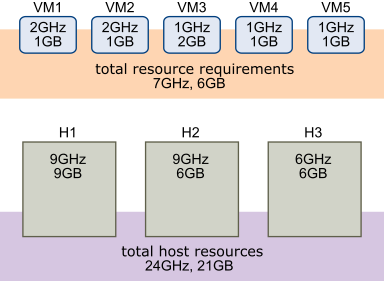You can configure vSphere HA to perform admission control by reserving a specific percentage of cluster CPU and memory resources for recovery from host failures.
With this type of admission control, vSphere HA ensures that a specified percentage of aggregate CPU and memory resources are reserved for failover.
With the cluster resources percentage option, vSphere HA enforces admission control as follows:
- Calculates the total resource requirements for all powered-on virtual machines in the cluster.
- Calculates the total host resources available for virtual machines.
- Calculates the Current CPU Failover Capacity and Current Memory Failover Capacity for the cluster.
- Determines if either the Current CPU Failover Capacity or Current Memory Failover Capacity is less than the corresponding Configured Failover Capacity (provided by the user).
If so, admission control disallows the operation.
vSphere HA uses the actual reservations of the virtual machines. If a virtual machine does not have reservations, meaning that the reservation is 0, a default of 0MB memory and 32MHz CPU is applied.
Computing the Current Failover Capacity
The total resource requirements for the powered-on virtual machines is comprised of two components, CPU and memory. vSphere HA calculates these values.
- The CPU component by summing the CPU reservations of the powered-on virtual machines. If you have not specified a CPU reservation for a virtual machine, it is assigned a default value of 32MHz (this value can be changed using the das.vmcpuminmhz advanced option.)
- The memory component by summing the memory reservation (plus memory overhead) of each powered-on virtual machine.
The total host resources available for virtual machines is calculated by adding the hosts' CPU and memory resources. These amounts are those contained in the host's root resource pool, not the total physical resources of the host. Resources being used for virtualization purposes are not included. Only hosts that are connected, not in maintenance mode, and have no vSphere HA errors are considered.
The Current CPU Failover Capacity is computed by subtracting the total CPU resource requirements from the total host CPU resources and dividing the result by the total host CPU resources. The Current Memory Failover Capacity is calculated similarly.
Admission Control Using Cluster Resources Percentage
The way that Current Failover Capacity is calculated and used with this admission control policy is shown with an example. Make the following assumptions about a cluster:
- The cluster is comprised of three hosts, each with a different amount of available CPU and memory resources. The first host (H1) has 9GHz of available CPU resources and 9GB of available memory, while Host 2 (H2) has 9GHz and 6GB and Host 3 (H3) has 6GHz and 6GB.
- There are five powered-on virtual machines in the cluster with differing CPU and memory requirements. VM1 needs 2GHz of CPU resources and 1GB of memory, while VM2 needs 2GHz and 1GB, VM3 needs 1GHz and 2GB, VM4 needs 1GHz and 1GB, and VM5 needs 1GHz and 1GB.
- The Configured Failover Capacity for CPU and Memory are both set to 25%.

The total resource requirements for the powered-on virtual machines is 7GHz and 6GB. The total host resources available for virtual machines is 24GHz and 21GB. Based on this, the Current CPU Failover Capacity is 70% ((24GHz - 7GHz)/24GHz). Similarly, the Current Memory Failover Capacity is 71% ((21GB-6GB)/21GB).
Because the cluster's Configured Failover Capacity is set to 25%, 45% of the cluster's total CPU resources and 46% of the cluster's memory resources are still available to power on additional virtual machines.